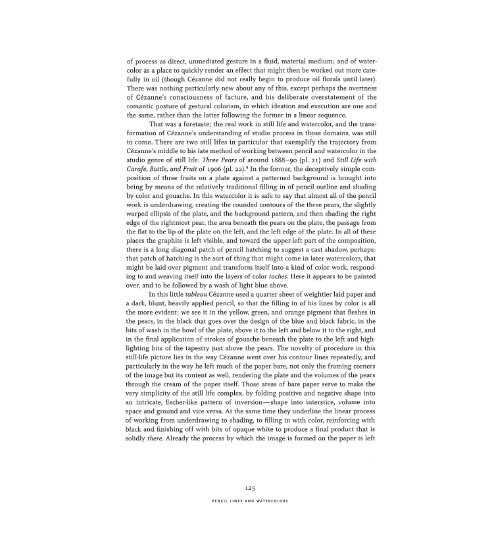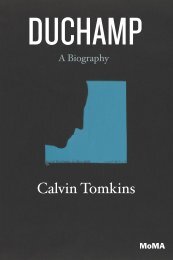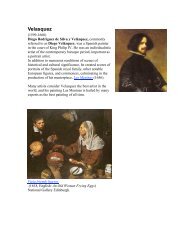Still Life in Watercolors
qbj8dgc
qbj8dgc
- No tags were found...
Create successful ePaper yourself
Turn your PDF publications into a flip-book with our unique Google optimized e-Paper software.
of process as direct, unmediated gesture <strong>in</strong> a fluid, material medium; and of watercolor<br />
as a place to quickly render an effect that might then be worked out more carefully<br />
<strong>in</strong> oil (though Cezanne did not really beg<strong>in</strong> to produce oil florals until later).<br />
There was noth<strong>in</strong>g particularly new about any of this, except perhaps the overtness<br />
of Cezanne's consciousness of facture, and his deliberate overstatement of the<br />
romantic posture of gestural colorism, <strong>in</strong> which ideation and execution are one and<br />
the same, rather than the latter follow<strong>in</strong>g the former <strong>in</strong> a l<strong>in</strong>ear sequence.<br />
That was a foretaste; the real work <strong>in</strong> still life and watercolor, and the transformation<br />
of Cezanne's understand<strong>in</strong>g of studio process <strong>in</strong> those doma<strong>in</strong>s, was still<br />
to come. There are two still lifes <strong>in</strong> particular that exemplify the trajectory from<br />
Cezanne's middle to his late method of work<strong>in</strong>g between pencil and watercolor <strong>in</strong> the<br />
studio genre of still life: Three Pears of around 1888-90 (pi. 21) and <strong>Still</strong> <strong>Life</strong> with<br />
Carafe, Bottle, and Fruit of 1906 (pi. 22). 9 In the former, the deceptively simple composition<br />
of three fruits on a plate aga<strong>in</strong>st a patterned background is brought <strong>in</strong>to<br />
be<strong>in</strong>g by means of the relatively traditional fill<strong>in</strong>g <strong>in</strong> of pencil outl<strong>in</strong>e and shad<strong>in</strong>g<br />
by color and gouache. In this watercolor it is safe to say that almost all of the pencil<br />
work is underdraw<strong>in</strong>g, creat<strong>in</strong>g the rounded contours of the three pears, the slightly<br />
warped ellipsis of the plate, and the background pattern, and then shad<strong>in</strong>g the right<br />
edge of the rightmost pear, the area beneath the pears on the plate, the passage from<br />
the flat to the lip of the plate on the left, and the left edge of the plate. In all of these<br />
places the graphite is left visible, and toward the upper-left part of the composition,<br />
there is a long diagonal patch of pencil hatch<strong>in</strong>g to suggest a cast shadow, perhaps:<br />
that patch of hatch<strong>in</strong>g is the sort of th<strong>in</strong>g that might come <strong>in</strong> later watercolors, that<br />
might be laid over pigment and transform itself <strong>in</strong>to a k<strong>in</strong>d of color work, respond<strong>in</strong>g<br />
to and weav<strong>in</strong>g itself <strong>in</strong>to the layers of color taches. Here it appears to be pa<strong>in</strong>ted<br />
over, and to be followed by a wash of light blue above.<br />
In this little tableau Cezanne used a quarter sheet of weightier laid paper and<br />
a dark, blunt, heavily applied pencil, so that the fill<strong>in</strong>g <strong>in</strong> of his l<strong>in</strong>es by color is all<br />
the more evident: we see it <strong>in</strong> the yellow, green, and orange pigment that fleshes <strong>in</strong><br />
the pears, <strong>in</strong> the black that goes over the design of the blue and black fabric, <strong>in</strong> the<br />
bits of wash <strong>in</strong> the bowl of the plate, above it to the left and below it to the right, and<br />
<strong>in</strong> the f<strong>in</strong>al application of strokes of gouache beneath the plate to the left and highlight<strong>in</strong>g<br />
bits of the tapestry just above the pears. The novelty of procedure <strong>in</strong> this<br />
still-life picture lies <strong>in</strong> the way Cezanne went over his contour l<strong>in</strong>es repeatedly, and<br />
particularly <strong>in</strong> the way he left much of the paper bare, not only the fram<strong>in</strong>g corners<br />
of the image but its content as well, render<strong>in</strong>g the plate and the volumes of the pears<br />
through the cream of the paper itself. Those areas of bare paper serve to make the<br />
very simplicity of the still life complex, by fold<strong>in</strong>g positive and negative shape <strong>in</strong>to<br />
an <strong>in</strong>tricate, Escher-like pattern of <strong>in</strong>version—shape <strong>in</strong>to <strong>in</strong>terstice, volume <strong>in</strong>to<br />
space and ground and vice versa. At the same time they underl<strong>in</strong>e the l<strong>in</strong>ear process<br />
of work<strong>in</strong>g from underdraw<strong>in</strong>g to shad<strong>in</strong>g, to fill<strong>in</strong>g <strong>in</strong> with color, re<strong>in</strong>forc<strong>in</strong>g with<br />
black and f<strong>in</strong>ish<strong>in</strong>g off with bits of opaque white to produce a f<strong>in</strong>al product that is<br />
solidly there. Already the process by which the image is formed on the paper is left<br />
125<br />
PENCIL LINES AND WATERCOLORS




